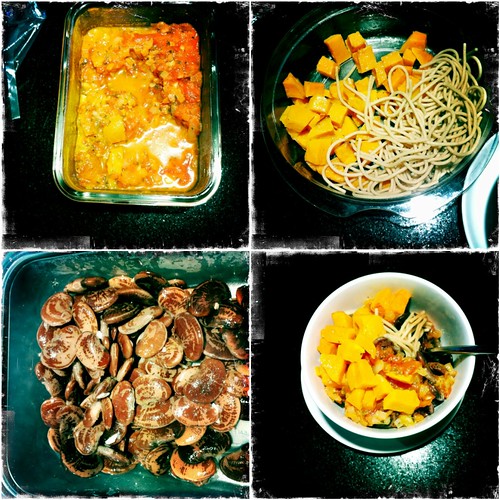Dear Chris, CJ, Jess, Jason, Ryan, Alice, Charlotte, Emily, Monica, Kelly, Katie 1, Kelsey, Mike, Aimee, Tracy, Molly, Jennifer, Katie 2, Becka, and Rachel*,
Thanks for that awesome class on Wednesday! I had a great time. It seemed like you did too. I hope you weren't faking it and I hope to see you again at another class. I learn a great deal from you fabulous class participants every time I teach. On Wednesday, I learned that taking time in the beginning to connect with each individual participant makes for a lot more intimate, interesting class. Getting more specifics from you about what you hoped to take away from the class helped me stay focused and organized. Thank you for opening up, thanks for the positive feedback, thanks for having fun, and thanks for the best class participation I've experienced yet! Spending three hours with you, ladies and gentlemen, expert Cooks for the Week, quesadilla-makers extraordinaire, was nothing short of absolutely lovely. Thank you thank you thank you!
To follow up on what we covered in class, I wanted to include in this post two things: (1) some less off-the-top-of-my-head, more comprehensive information on poaching chickens and making your own stock; and (2) a recipe that I put together for lunch this week using some of the components of our cook-for-the-week curriculum, as well as some other made-ahead items, that ended up so flavorful and interesting that you'd never have guessed it was a hodgepodge meal.
First things first: chicken stock. The perfect "recipe" for chicken stock, in my opinion, is that found in Alice Waters's The Art of Simple Food. It basically goes like this: place 1 whole chicken and 1-1.5 gallons cold water in a stock pot. Bring to boil and then add 1 carrot, a rib or 2 of celery, 1 onion halved, 1 head of garlic cut in half, 1/2 teaspoon black peppercorns, salt (I suggest starting with one tablespoon and adding more to taste once you are using the stock in a soup or other dish), and a bouquet garni of parsley and thyme sprigs and a bay leaf. Simmer for 4-5 hours. Strain and store in refrigerator for a week or freezer for a few months.
As I mentioned in my class, in addition to adding about a cup of white wine or 1/2 cup lemon juice (and the lemon rinds!) per gallon of water, I take a more anything-goes, resourceful approach, appreciating the flavor and aroma variations that grace our dinners depending on whether I've thrown in butternut squash peel and pith or some cilantro that didn't manage to get used at its peak. (I literally save these food odds and ends in a bag in my freezer to throw into my next batch of stock.) Some items that influence the flavor and depth of broths more decisively are the following: dried mushrooms, citrus rinds, star anise, whole cloves and/or cardamom pods, root vegetables, fresh herbs, and ginger (to name a few). Anything roasted - the Thanksgiving turkey's carcass or a couple heads of garlic - will impart a smokier, heartier flavor to your broth.
To get some chicken out of this process, remove the whole chicken once it's cooked through - about an hour if it was fresh or thawed and about 90 minutes if you started with a frozen whole chicken - allow to cool a bit, peel off the skin, and then shred the chicken with forks or your fingers. Return the skin and the bones to the pot if you want to continue making a rich broth and simmer for another 3-4 hours.
If you'd like to avoid touching raw meat altogether, just use a rotisserie chicken (or make vegetable stock instead). Start with the whole chicken for a really flavorful stock. Using just the carcass, however, will still make a decent stock, especially if you've got a good mix of aromatic vegetables and herbs in the pot.
I hope you'll all make stock soon and let me know how it goes. If it doesn't have as much flavor as you'd like, add salt 1-2 teaspoons at a time and keep tasting. Adding a little bouillon isn't cheating either. Our American palates are used to salty, rich broths.
And now to the roasted squash-pasta bowl. It's such a unique combination of flavors - the sweetness of the squash, the earthiness of the whole grain pasta, the tartness of the tomato sauce, and the creaminess of the chestnut-like Christmas lima beans all at play together form something really special. I wish you could be here to try it. But instead, here's a bite for you to look at.
Sorry about the weird shadow. Let's call it artsy and enjoy our lunch.
Butternut Squash-Pasta Bowl with Chunky Herbed Tomato Sauce and Christmas Lima Beans
From yours truly
Yield: 4 servings
1 small butternut squash, peeled and cut into 1/2" cubes
olive oil, salt and pepper
1/4 pound whole wheat spaghetti or other pasta (a nice handful)
2 cups cooked butterbeans, lima beans, Christmas lima beans, or other large creamy bean
2 cups chunky herbed tomato sauce* (homemade ideally)
Preheat oven to 400 degrees. Toss cubed butternut squash with 2 tablespoons olive oil and some salt and pepper on a baking sheet. Place in the oven and roast for 20-30 minutes, until just browning and softened. Meanwhile, cook pasta according to package instructions and drain well. In each of four bowls, place 1/2 cup cooked pasta, top with 1/2 cup tomato sauce, followed by 1/2 cup beans and finally a quarter of the roasted squash. A sprinkle of nice parmesan would be a lovely addition as well.
I had all these ingredients except for the pasta in my refrigerator after a weekend of embracing "Cook for the Week" methods. I boiled the pasta, threw this together, and quite impressed myself. I hope you do the same! xoxo
* I hope I'm not forgetting anyone and/or not getting anyone's name wrong. The chunky herbed tomato sauce I used was the one I made with my Cook for the Week class on Wednesday. It's perfect in about a hundred different ways and works beautifully in countless dishes. And yet it hasn't appeared on this blog yet! It will. But it deserves its own post. Once I get to it, I'll update this post with a link. In the meantime... your favorite marinara, purchased or homemade, should do the job nicely.



No comments:
Post a Comment